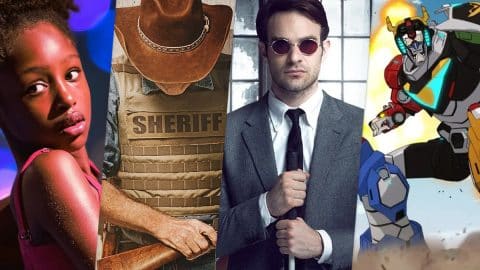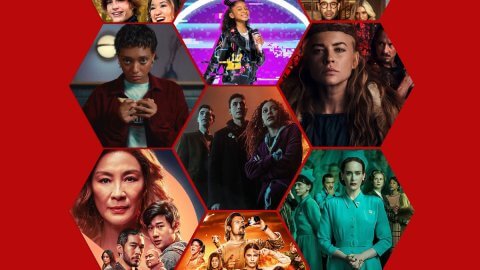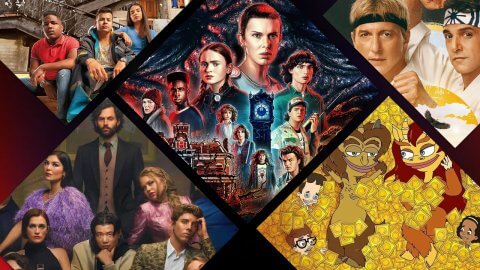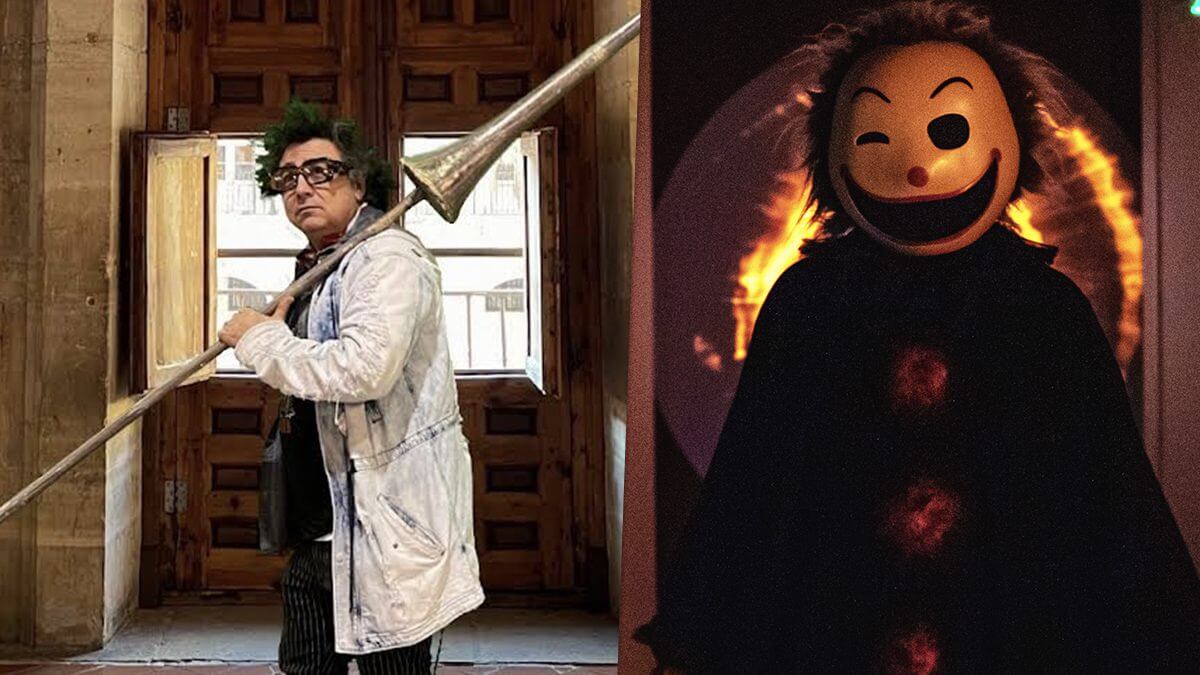
Pictures courtesy of Markos Keyto and Netflix
The Spanish horror thriller Killer Book Club was released on Netflix globally in August 2023 and is already terrifying audiences thanks to the film’s elaborate death scenes, chases and twists. We spoke to production designer Markos Keyto who was key to creating the visuals.
Killer Book Club is very reminiscent of the 90s slashers I Know What You Did Last Summer and Urban Legend, so if you were a fan of those films, you would enjoy this new Spanish-language movie that’s flown under the radar.
In case you aren’t familiar with the film, the synopsis is as follows:
“Eight horror-loving friends fight for their lives when a killer clown who seems to know the grim secret they share begins to pick them off, one by one. The film was directed by Carlos Alonso Ojea with Carlos G. Miranda serving as the writer. The producers are Raimón Masllorens, Pio Vernis and Arlette Peyret.”
When watching the film, and the trailer for that matter, it’s hard not to notice the vivid production design by Markos Keyto. To learn more about the look of the film, we conducted the below Q&A with Markos.
WON: How did you get the job as a production designer for Killer Book Club?
Netflix was asking for a very international look for this film, apparently, they didn’t want a very local product, they wanted it to reach a very wide audience. The producers from Brutal Media had recently worked with Pablo Díez as DP and proposed this film to him. Pablo and I have worked together on many occasions and our collaborations generate a very special style. When the producers saw my style, they wanted to meet me, and from the first moment we met we understood each other very well. Raimon, Arlette and Pío, who were the executive producers, were clear in that they wanted something of really good quality, they cared a lot about the visual/creative aspect and they listened to the director’s requests. I was delighted to find a structure so willing and open to create something special. So, they decided I was the right person and I offered to play with them.
WON: How would you describe the overall look of Killer Book Club?
I wanted light, I didn’t mind that there would be dark scenes, but in the end, the idea had to be very bright. The HDR helped us, we wanted to use it and enhance the story with it. As always, I worked very closely with the cinematographer, Pablo Díez, who is one of the best in his profession, controls technique like no other and knows how to put it at the service of Art. We did tests to know how our camera would work and that was an important reference to work with colors, materials, textures, points of view, perspectives, etc.
The first descriptions I encountered of the overall look were very gray and sad. The references that were discussed at the beginning were of a very dark and old-fashioned concrete and steel university.
The student residence was something decrepit and distressing; the morgue, the basements, even the look of the characters took me to a place I didn’t want to go. When I read the script for the first time, I didn’t quite understand why someone would have come up with so much visual sadness, because the truth is that to me only flashes of color jumped out of those pages, so I got to work and created a visual look charged with energy and light.
For me it was important to convey a happy and lively world; and for the characters to be perceived as a group of great guys and gals that we fell in love with from the first moment we met them. I wanted to get the audience confused and wanted each and every one of them to be so likeable by part of the audience that we didn’t know who we wanted to save first. I loved the idea of letting the audience get confused by their own personal choices.
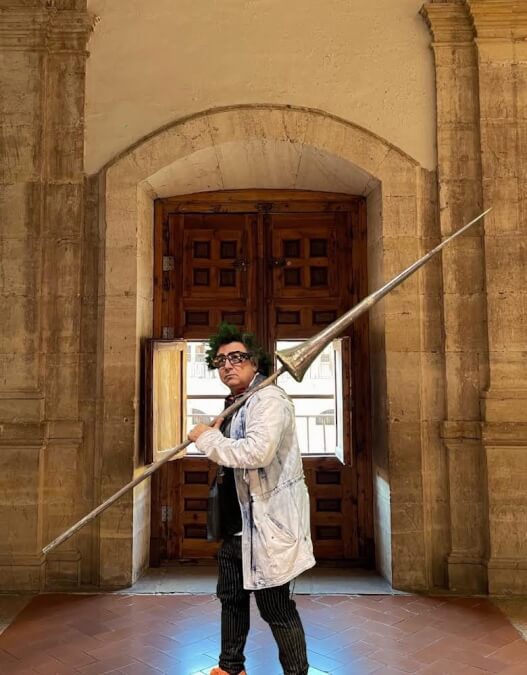
Picture courtesy of Markos Keyto
WON: A lot of Killer Book Club was shot in Madrid. What is the biggest difference between shooting a film in Spain versus shooting in the U.S.?
Obviously, we are talking about two different idiosyncrasies and somewhat different organizational structures. Spaniards are very devoted and fun, and that, for me, is essential in a team, they know how to work hard and professionally without forgetting that life is much more; With Spaniards it is very easy to create very intense personal ties. In any case, here in the United States or wherever I go, I like to create a cohesive and motivated team. I want everyone to be involved on a creative level. I like them to feel that what we do belongs to all of us and I always seek to create a family with all of them. Now, for example, I have an important challenge, since I will move to Thailand for a few months for a shoot and I will have to create one of these teams by people from a very different and special culture; I am looking forward to meeting this new family.
On the other hand, the figure of the Production Designer as understood in large American productions is not well known within the industry in Spain, so it had to be made accessible to everyone and be understood how we should function in this structure.
But it was very easy to establish this way of working in this film, the producers believed in my position and supported me throughout the process, since we were all looking forward to getting the visual style of the film very consolidated.
Gathering all my teams: Art, Costume, Makeup, Special and Visual Effects and telling them what we were going to do, conveying all of my ideas to them and connecting them all with each other, and involving them in the whole creative process, was something fun and that many of them were not used to.
My main ally for this was my Art Director, Ana Medina. She was used to working in Madrid, and she was the one who would direct our Art Team, so she was the one who was in charge of bringing in the best talent to build our team.
All the people that made up my departments in this film in Spain had a very high level of professionalism that was very much up to par with the standards of the American industry. I managed to surround myself with a wonderful team overall.
WON: Can you talk about working with director Carlos Alonso Ojea. Have you two worked together before? What were some of his main points of how he wanted the film to look?
I met Carlos Alonso Ojea in a video call for this film, I was here in LA and he was in Barcelona. We didn’t know each other from before but we clicked from the first moment. I had already read the script several times and my mind tends to overflow uncontrollably from the first reading, so when we first met neither of us could stop saying crazy things. We met in Madrid to start off; we were the first ones to arrive, and from that moment on, we did not separate. We went over the script thousands of times, so many times that the writer panicked, but Carlos García Miranda, our writer, didn’t take long to join us in our creative film-making world. I knew we were trying to take his novel to the level he dreamed of.
The Director/Production Designer tandem is essential, according to my way of making films. We plan everything together: characters, looks, locations, deaths, the relationship between the spaces and our characters, the evolution of the story, the way to reach our audience.
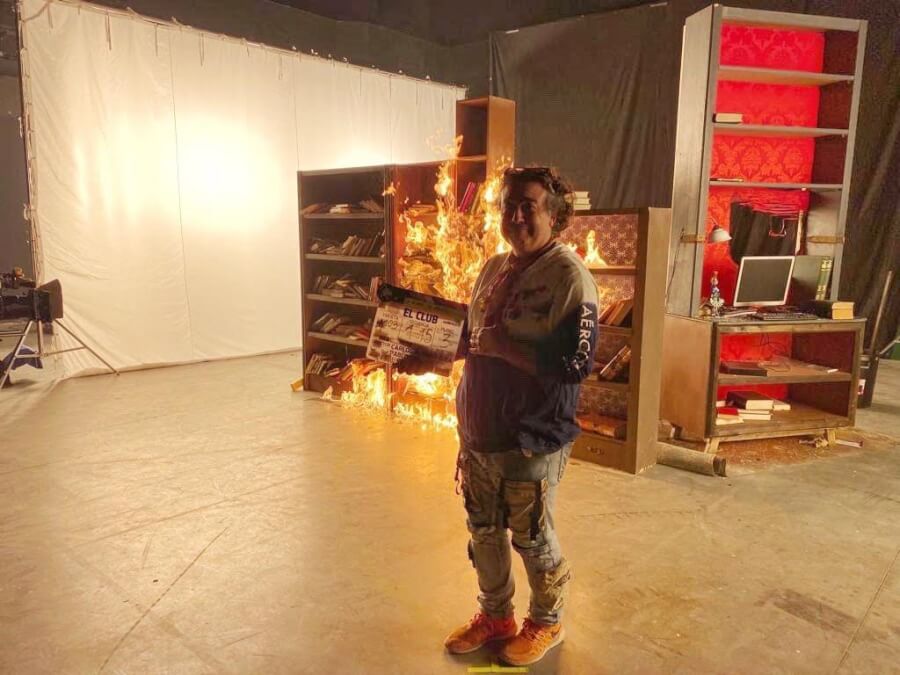
Picture courtesy of Markos Keyto
We spent several weeks doing the location scouting; we couldn’t find what we were looking for, nor was it easy to fit the whole story in one place, so I proposed to make a collage of different places. Getting coherence between them was not easy either. I am very picky when it comes to choices because I value architectural styles, materials, colors, and many other things that make it very difficult to fit everything together. I drove the Locations Team crazy, but Silvia and Nuria were so enthusiastic about the challenge that they didn’t stop looking for things until they found what we were looking for. Luckily the producer, Raimon Masllorens, trusted me and allowed us to search until we found the best locations for the film. This time was very fun and enriching, since Carlos and I shared many experiences and moments that we used to shape our film and forged a precious friendship.
WON: What was your favorite set to design in Killer Book Club?
Perhaps you think that we had a very high budget, well no, it was rather a very tight one, and everything that happened in the film had to fit within those numbers. So, I juggled with what we had. When I started projecting the library, my team and the producers thought it would blow the budget. We built a spectacular library, and then everything was recycled and turned into new sets. My construction team didn’t quite understand how we would do it, but as soon as they saw the first movement they burst into creativity. All the shelves were redesigned with small changes and with them we built the house that we would burn down. But in order to take advantage of it before burning it, we divided the scene in two, leaving the part where we would burn everything for the last day of shooting. In this way we were able to use the material for the book fair, from there we used it to build some structures that would support the boiler tubes, and in the end, we reconstructed the areas that we would burn in the house at the beginning of the film. So, this game was pretty crazy but a lot of fun for everyone.
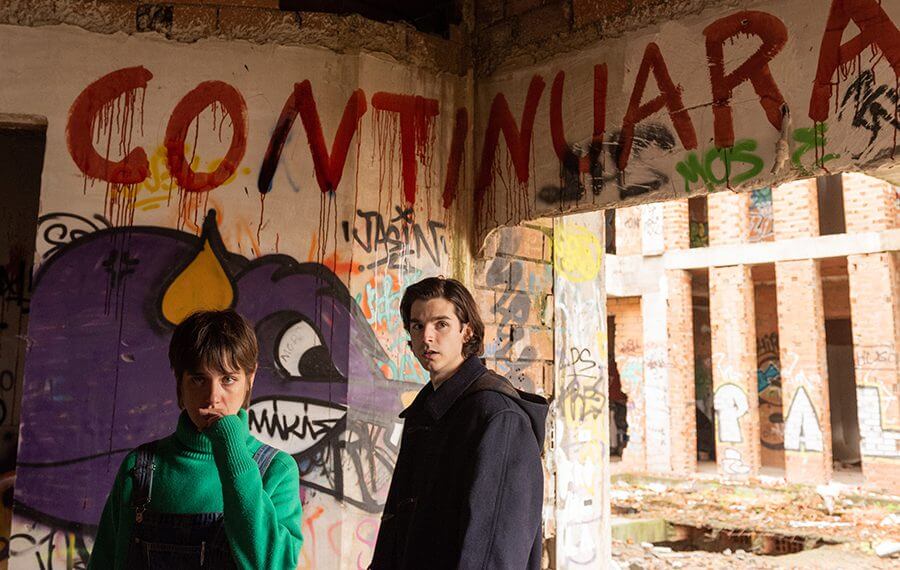
EL CLUB DE LOS LECTORES CRIMINALES (L to R) VEKI VELILLA as ÁNGELA, ÁLVARO MEL as SEBAS in EL CLUB DE LOS LECTORES CRIMINALES. Cr. FELIPE HERNÁNDEZ/NETFLIX © 2022
The producers looked for a way for us to shoot in real boilers for budget reasons, but I was convinced from the beginning that we had to build it to get what we wanted, I also knew that they would not allow us to start a fire in a real boiler, so in the end, we built that entire set in the basement of an old factory. This, next to the reading club classroom, was one of the last sets in which we would shoot and at that time the rhythms of construction, assembly and filming were very intense. I remember that two days before shooting at the boilers set the First AD told me: “Here we will shoot for half a day.” I smiled at her and said: “Sara, calculate two days here.” She told me: “That can’t be, half a day is enough” and I replied to her, “When the Director and the DP enter this set, they won’t want to leave for two days,” and that’s exactly what happened. Carlos didn’t know what he was going to encounter, Pablo did, because he knows me well. Once the team for the shoot was there, they all enjoyed playing with the toy of a set that we had given them.
WON: Between the balloons, lighting and other objects placed in the scenes, red seems to be in the reoccurring color palette. Was this on purpose?
The color palette of my films is something that appears almost from the first moment. I really think it’s the first thing that comes out. I see the stories more in colors than in shapes. However, I like to think that it arises in a profound way. I don’t usually think about it, or reason about why something should be one color or another, I just like to feel that it flows. In the moment that I read the script the letters are stained with colors, and then I try to understand why they take on the colors that they do. Nor are they rigid colors, since the progressive reading of the script mutates those shades until, little by little, they are consolidated. Later, when they are defined in the color palette, I try to answer the questions about why a scene has taken this path and why some characters go into others or why I imagine an action tinged with a certain color. This way I can explain to everyone why we use one color or the other, and in this way we all align ourselves on the concept.
The red color, of course, was on purpose. I fervently believe that the intention does not have to be reasoned or premeditated, but obviously, when I do something, it is because I want it to happen. Red is the color of blood; this is more than obvious. We were doing a slasher and we were going to get a lot of deaths, hopefully, red would come out at some point. Our clown was death itself and with it, blood, so we decided that this would be its color. It is in its mask, in the buttons of its costume, in the color of its profile, and we use it in the light that would give off all its influence. For this, for example, we used it on the characters’ phones every time The MadClown sent a message, illuminating their faces. It was also always present in some elements or practical lights that surrounded our clown.
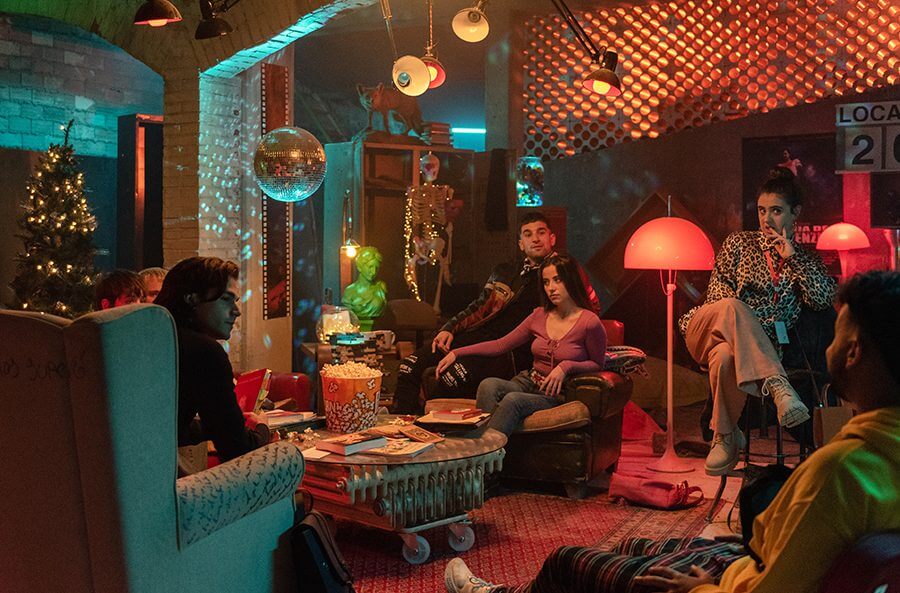
EL CLUB DE LOS LECTORES CRIMINALES (L to R) ÁLVARO MEL as SEBAS, CARLOS ALCAIDE as RAI, ANE ROT as SARA, MARÍA CEREZUELA as EVA, HAMZA ZAIDI as KOLDO in EL CLUB DE LOS LECTORES CRIMINALES. Cr. FELIPE HERNÁNDEZ/NETFLIX © 2022
WON: Killer Book Club looks very reminiscent of the 90s slasher films such as I Know What You Did Last Summer and Urban Legend. Did you go back and watch those films to get inspiration for the look of Killer Book Club?
Well, the first thing the producers told me was that we were going to make the first Spanish slasher. It was evident that we would use all the ingredients of a slasher to spice up this story, without a doubt. The truth is that I think I saw these movies in the 90s, but I did not review anything of the genre during the creative process.
In fact, Carlos started sharing a folder full of movie links, which I never opened. Carlos knew this and laughed about it, but he understood well how my mind worked by now. I don’t usually use references of other films, especially if they are from the same genre I am working on. It is true that I watch a lot of movies, perhaps not as many as I would like, and it is also true that my memory works in a somewhat strange way, since after two weeks, if I watch the movie again, I am surprised as if I were watching it for the first time. This does not mean that memories and images are not stored in my memory, but what is clear to me is that they do not do so in the same way as for most humans. That is why it is very difficult for me to name references, since when I do something, I don’t know if it occurred to me or if it is the result of an internal short circuit of memories.
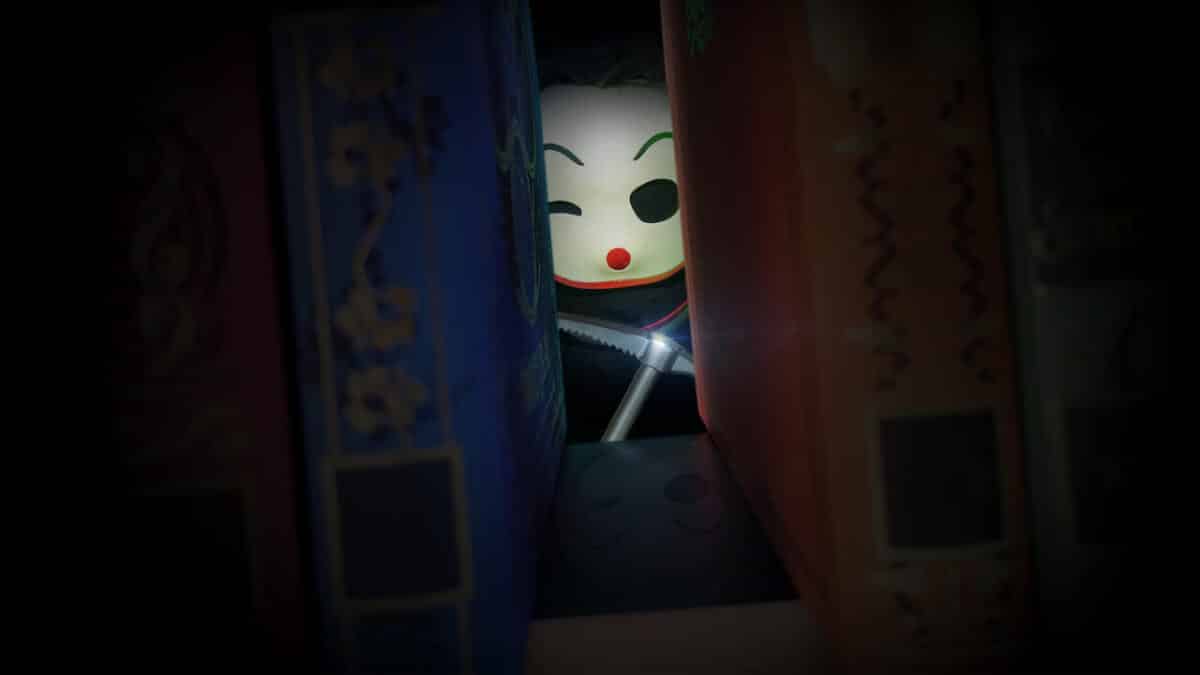
Picture: Netflix
The film is based on a novel, and in the novel, there are many references to horror movies and novels, both Carlos (the director) and I decided to avoid these references being expressed verbally so that we would feel these references visually but never name them.
What I could not avoid was making references to Kubrick. The forensic room at the medical university, the chess, the typewriters and his “ALL WORK AND NO PLAY MAKES JACK A DULL BOY,” HAL’s eye, and many more details with which I sprinkled the film. The art of symbolism as part of the cinematographic language is one of my favorite weaknesses. Perhaps many do not appreciate these details; some others will read between the lines far beyond the obvious.
WON: Is there a particular scene you put a lot of effort into, production design-wise, that viewers might not be aware of?
I would like to believe that I did this in all of them, let me explain. I do not create worlds to be perceived as a stage. I don’t want to be valued for my decorations. I like that everything is so coherent that the spectator believes that they are inside the film. Earlier in my career, my ego suffered a bit when even the crew would come to a set and think they were on a real location, even saying: “Wow, you didn’t have to do anything here.” Now, I feel satisfied when we have turned a box into a real-world location and that it is unrecognizable as a set. I don’t want my work to be noticed, what I want is for the story to work so well that nobody has to talk about how good or bad we have done the work in my department.
With all this, back to the question, the answer is yes. We put a lot of effort into the whole movie and I’ll be happy if the audience doesn’t notice this. My Art, Construction, Setting, Graphics, Costume, Makeup and Special Effects teams worked hard throughout the film.
I hope I have the opportunity to bring them all together again on more occasions in the future.
WON: Is there anything else you would like to add about your work on Killer Book Club?
Value and look beyond easy criticism. There are people who make movies and tell stories with love and intention.

